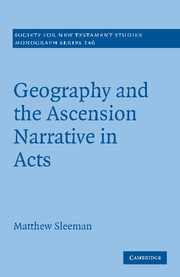2 - Finding a place for ascension geography
Published online by Cambridge University Press: 13 February 2010
Summary
Both contentions made in Chapter 1, that the ascension in Acts requires a narrative reading, and that the ascension concerns problematic conceptions of Christological presence and absence, point towards the need for geographical theory to inform a richer spatial understanding of the ascension. Yet, as Chapter 1 has also shown, narrative criticism has tended to underplay the geographical or spatial aspects of the text. All too often, geography is reduced to background scenery, or considered only as a flash of ‘colour’, or assumed to function as an already-made ‘setting’ in which narrative action subsequently occurs. Geography is rarely viewed as being genuinely involved in developing the narrative and its theological message.
This chapter explores the reasons for this marginalisation of geography, arguing that it unjustifiably constrains a fully critical reading of the text, and proposes an alternative understanding of space which Part II of this study will use to read Acts. Sections 1 and 2 identify a critique of the neglect of space which has arisen within human geography. Then, after a survey of previous attempts to read scripture for its spaces (section 3), sections 4 and 5 outline and position the theory and method utilised in Part II.
The forgotten place of geography
Biblical studies' neglect of geography reflects a wider marginalising of the spatial aspect of reality within modern Western social theorisation. The bounds of this disregard of geography are broad, mapping a larger intellectual stance over the past two centuries.
- Type
- Chapter
- Information
- Geography and the Ascension Narrative in Acts , pp. 22 - 56Publisher: Cambridge University PressPrint publication year: 2009



